April 10th is Gopher Tortoise Day!
On any given day in Florida, gopher tortoises may be seen out and about in pine flatwoods or scrub habitats, looking for lunch or basking in the sun… perhaps even in your own backyard!
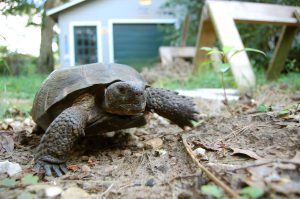
Gopher tortoises have a dark grey or brownish domed shell, often peppered with the sand from their very own burrow. They have a strong, sharp beak-like mouth that is adapted for eating their favorite foods like native grasses, gopher apple, and prickly pear cactus. They have short, stubby legs with shovel-like front feet that are the perfect tools for digging in the sand. Young gopher tortoises are about 1.7 inches when they hatch, and their shell is more yellow. Their shells stay soft for up to 7 years. Adult gopher tortoises average 10 inches in diameter and live to be 40-60 years old!
An important keystone species

Like the necessary top stone that holds up the arch of a bridge, a keystone species is necessary to its ecosystem. Keystone species, like gopher tortoises, often determine the health of their ecosystem and the other species that live there. Research has shown that over 350 different species of animals rely on the gopher tortoise and its burrow. The burrow can be 6.5 feet deep, and on average 16 feet long, although some burrows can be up to 45 feet long. Burrows have only one opening, but a tortoise may use more than one burrow at a time. Burrows remain about the same temperature and humidity throughout the year, providing respite from the heat of summer and the coolness of winter.
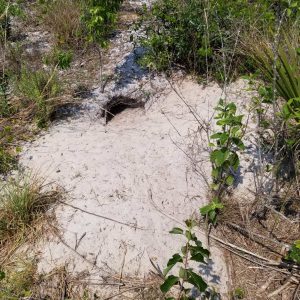
Photo credit: K. Clements
Burrows are also a refuge from fires that burn through the scrub helping regenerate native plants, restore nutrients to sandy soil, and clear patches of open ground for gopher tortoise travel and Florida scrub jays to cache their acorns. The endangered indigo snake and gopher frog, gopher mouse, rabbits, racerunners and skinks at any given moment may be using the gopher tortoise burrow to shelter from the weather, lay eggs, hide from predators, or stay safe from a fire. If gopher tortoise populations decline, many other animal populations will be negatively affected.
Threats to the Gopher Tortoise
Habitat destruction is the greatest threat to the continuation of the gopher tortoise. They prefer high, dry, sandy land to dig their burrows. This is often the type of land that is chosen for development, mining, citrus and pine plantations. Fire suppression and invasive plants change habitats so that they do not provide the components necessary for the survival of the tortoise. Tortoises are also susceptible to upper respiratory tract disease (URTD).
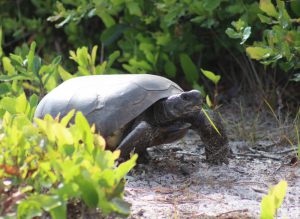
Photo credit: K. Clements
You Can Help!
This year, you can celebrate gopher tortoises and assist with their conservation by making your yard tortoise friendly. The Florida Fish and Wildlife Conservation Commission (FWC)’s new Gopher Tortoise Friendly Yard Recognition Program honors Florida’s private landowners for contributing to wildlife conservation. Gopher tortoises live in all 67 counties in Florida. More than half of the land in Florida is privately owned and the FWC recognizes the critical role private property owners play in conserving gopher tortoises. Private landowners who the take steps to protect gopher tortoises and their burrows will be recognized with a sign for their property and a certificate.
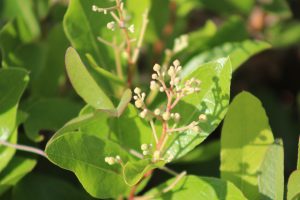
Any Florida property owner can take steps to make their land more gopher tortoise friendly. To apply for recognition, you must sign the Acknowledgement Form, provide contact and property information, and complete the Gopher Tortoise Friendly Yard checklist through the FWC. Gopher tortoise friendly plants include wiregrass, broadleaf grasses, wild peas, blueberries, and prickly pear cactus. To learn about which plants are best, click on your region of Florida HERE.
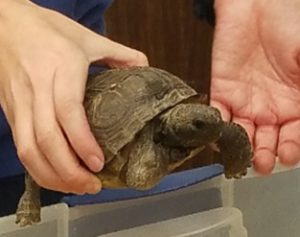
How else can you help?
- Never transport a tortoise, it is illegal and can spread respiratory disease to other tortoises. If you find a tortoise in need of help, contact FWC.
- The gopher tortoises’ only real predators are humans and dogs, so keep your dogs leashed and watch out for our tortoises on the roads or in your neighborhood!
- Avoid mowing, digging, or driving over the ground within twenty-five feet of the burrow to help protect it.
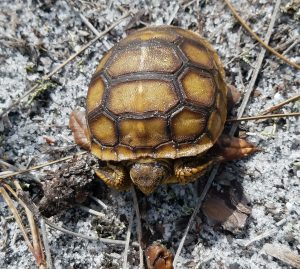
Young gopher tortoise at Manasota Scrub Preserve.
Photo credit: K. Clements - Never walk on the apron! The apron is the loose sandy soil at the door of the burrow. Often the apron is the perfect place for the mother tortoise to lay her eggs. It can take a female tortoise 10-20 years to reach maturity and she only lays an average of 6-8 eggs once a year in the summer.
- Remember both the tortoises and their burrows are protected under state law and must be left alone! Interactions can cause stress and affect eating and mating behavior.
- Watch our webinar!
Read all our Wild Sarasota blogs HERE
 0
0
